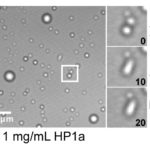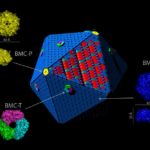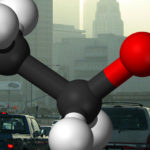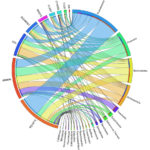In a paper published June 21 in the journal Nature, Berkeley Lab Biological Systems and Engineering Division researchers Amy Strom and Gary Karpen provide evidence that liquid-liquid phase separation in the nucleus of cells plays an important role in how genes are regulated to be silenced or expressed. They observed that heterochromatin—an unusual part of DNA that generally must be silenced for cells to function properly—is sequestered in droplets that fuse together just like two drops of oil surrounded by water. Understanding this mechanism could open up a third of the genome that was previously inaccessible to genome manipulation and gene therapy, Karpen said. Read more in the News Center release.
How to Build an Artificial Nano-factory to Power Our Futures
Many bacteria contain structures called carboxomes that act as mini factories for various purposes, such as building sugar from carbon dioxide through photosynthesis. Researchers affiliated with Berkeley Lab’s Molecular Biophysics and Integrated Bioimaging (MBIB) Division and the Department of Energy Plant Research Laboratory and Department of Biochemistry and Molecular Biology at Michigan State University are studying how these factories are constructed and how they function. In a key step toward identifying the essential building blocks, Manuel Sommer and Cheryl Kerfeld have analyzed more than 200 sets of genes from different cyanobacteria—also known as blue-green algae—that contain carboxysomes. The work lays the foundation for designing new kinds of factories that could produce synthetic materials, such as fragrances or the precursors for green fuels. The study was published in the Journal of Experimental Botany. Read more from the MSU-DOE Plant Research Lab.
A Surprise Just Beneath the Surface in Carbon Dioxide Experiment
Research co-led by Berkeley Lab researchers Junko Yano (MBIB) and Ethan Crumlin at the Advanced Light Source (ALS), with collaborators at Caltech’s Joint Center for Artificial Photosynthesis (JCAP), has revealed a surprising driver of a chemical process to reformulate carbon dioxide into more useful compounds. X-ray experiments coupled with theoretical models showed that oxygen atoms near the surface of a copper sample had a more dramatic effect on the early stages of a reaction with carbon dioxide than earlier theories could account for. This work could help make reactions more efficient in converting carbon dioxide into liquid fuels and other products. Read more in the News Center release.
Energy Secretary Perry Lauds California’s National Labs During China Trip
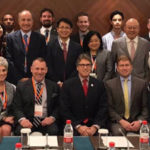 The Bay Area Council recently traveled to China for a global conference on climate change. The delegation, which included Associate Laboratory Director for Biosciences Jay Keasling, met with US Energy Secretary Rick Perry to discuss the important role of California’s national labs, including Berkeley Lab, in advancing clean energy technology. Perry called California’s labs “crown jewels.”
The Bay Area Council recently traveled to China for a global conference on climate change. The delegation, which included Associate Laboratory Director for Biosciences Jay Keasling, met with US Energy Secretary Rick Perry to discuss the important role of California’s national labs, including Berkeley Lab, in advancing clean energy technology. Perry called California’s labs “crown jewels.”
JGI Researchers Release 1000+ Microbial Reference Genomes
Department of Energy Joint Genome Institute (DOE JGI) and Biosciences Environmental Genomics and Systems Biology (EGSB) division researchers have released 1,003 reference genomes for diverse bacteria and archea isolated from environments ranging from sea water and soil, to plants, and to cow rumen and termite guts. The release is the largest to date from JGI’s Genomic Encyclopedia of Bacteria and Archaea (GEBA) initiative, which seeks to fill in unexplored branches of the tree of microbial life. JGI’s Supratim Mukherjee and Rekha Seshadri were co-first authors on the paper published in Nature Biotechnology; senior author Nikos Kyrpides and co-authors Natalia Ivanova, Axel Visel, Tanja Woyke, and Yasuo Yoshikuni have secondary affiliations with EGSB. The genomes are publicly available through the Integrated Microbial Genomes with Microbiomes (IMG/M) system. Read more on the JGI website.
- « Previous Page
- 1
- …
- 150
- 151
- 152
- 153
- 154
- …
- 213
- Next Page »
Was this page useful?


